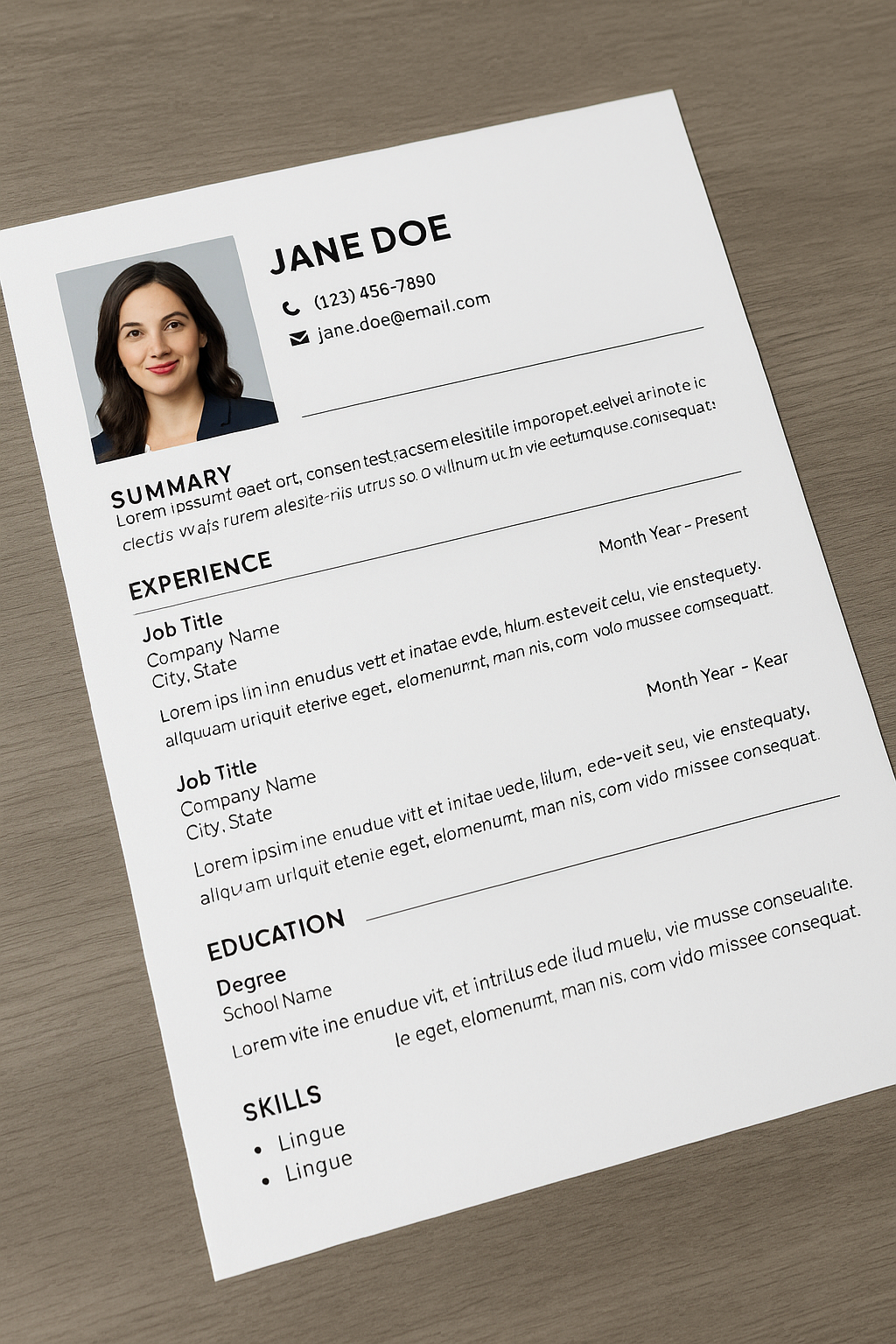Want a Job in 2025? Here’s What Actually Matters
The hiring landscape has shifted. In 2025, the way people land jobs looks very different than it did just five years ago. Traditional résumés? They're still around, but they no longer carry the weight they used to. If you’re serious about getting hired this year, it’s time to reframe your job search strategy around what actually matters: trust, visibility, references—and a powerful headshot.
This guide outlines everything you need to know about getting hired in 2025. Whether you’re unemployed, transitioning careers, or simply ready for a new opportunity, here’s what to focus on—and what to avoid.
1. Résumés Are Overrated—Stop Obsessing Over Them
It might feel strange to hear, but many recruiters and hiring managers barely read résumés anymore. Automated applicant tracking systems (ATS) scan them for keywords, and when actual humans review them, they spend about 6–8 seconds per résumé. That’s barely enough time to skim your name, job title, and education.
In 2025, résumés function more as a formality than a deciding factor. Yes, you should have one—but don’t spend weeks obsessing over the layout, colors, or creative formatting. The content matters more than the aesthetics. Keep it clear, factual, and focused on measurable results.
Actionable Tip: Use a clean, one-page format. List your most recent 2–3 roles with quantifiable accomplishments (e.g., “Increased team productivity by 28%”). Remove outdated or irrelevant experience. Use free tools like Standard Resume or Teal to build modern, ATS-friendly templates.
2. Your Headshot Matters More Than Your Résumé
First impressions are no longer made through words—they're made through visuals. In today’s digital-first hiring world, your headshot can open doors faster than any document.
Hiring managers look at your LinkedIn photo, your profile picture on networking platforms, and even your Zoom avatar before they look at your experience. A professional, approachable, and confident headshot builds instant trust. It communicates presence, reliability, and personality.
What Makes a Great Headshot in 2025:
High-Resolution Image: Use a DSLR or modern smartphone. Don’t crop from a group photo.
Natural Lighting: Avoid harsh flash or dim indoor lighting. Soft daylight works best.
Neutral Background: Choose light-colored walls or outdoor settings with blurred backgrounds. No messy bedrooms or car selfies.
Professional Attire: Wear what you’d wear to an interview. Avoid busy patterns.
Relaxed Expression: Smile naturally. You want to look warm, trustworthy, and competent.
Actionable Tip: Book a 20-minute session with a local headshot photographer. If your budget is tight, use a tripod or ask a friend. Aim for a centered, eye-level photo with open body language and good posture.
Update your LinkedIn profile and email signature with this headshot immediately.
3. Build References That Speak Before You Do
References are everything in 2025. Not just the names you list on a form—but the people who will proactively speak up for you behind closed doors.
Think about who would recommend you without hesitation. These people are your career capital.
How to Strengthen Your References:
Reconnect Intentionally: Send a friendly message every few months. Share updates and ask about their work.
Be Helpful First: Refer them to clients, send resources, or celebrate their wins online. Give without asking.
Ask for Testimonials: After a successful collaboration, request a 2–3 sentence quote you can use on LinkedIn or your website.
Keep Records: Create a list of 3–5 advocates you can rely on. Track their contact info and the roles they’d be best to speak about.
Actionable Tip: Before applying, give your references a heads-up. Remind them of the project you worked on together and the skills you want them to highlight.
4. Grow a Reputation, Not Just a Résumé
Your reputation is your résumé now.
A hiring manager might not read your PDF, but they will Google you. They will check your LinkedIn. They might glance at your portfolio or scroll your content.
How to Build a Visible, Trustworthy Reputation:
Optimize Your LinkedIn: Use a custom banner image, keyword-rich headline, and a summary that tells your career story in 3–5 sentences.
Post Consistently: Share one insight, lesson learned, or link per week. Comment on others’ posts with thoughtful reactions.
Show Work Samples: Add PDFs, videos, links, or case studies under each job or in your featured section.
Build Thought Equity: Volunteer to join a panel, write a guest blog, or participate in an industry Slack group.
Actionable Tip: Google yourself. What comes up? Add your name to bios on content you contribute to. Buy a domain name for your portfolio. Create a digital paper trail that reflects who you are professionally.
5. Volume Still Wins—To a Point
While relationships and referrals are powerful, volume still matters.
The job market is a numbers game. The more roles you apply to, the more chances you create—especially if you’re early in your career or switching fields.
How to Apply with Purpose:
Set a Weekly Target: Aim to apply to 5–10 roles per week in your niche.
Use Job Trackers: Use tools like Huntr or Teal to track your status and follow-ups.
Customize Every Time: Tailor your headline, intro sentence, and bullet points to the job description.
Follow Up Right: Wait 5 business days after applying, then send a brief message to the recruiter on LinkedIn referencing the role.
Actionable Tip: Block out two 90-minute sessions each week to submit applications in batches. Don’t apply from your phone while distracted. Treat it like high-focus work.
6. Let Opportunities Find You
Once you build a credible online presence and strong network, job opportunities often come your way.
You might be invited to interview, asked to apply, or even offered a consulting project without ever submitting a résumé. This is the result of visibility and trust.
How to Attract Inbound Leads:
Clarify Your Brand: Use one sentence to describe what you do and for whom.
Keep DMs Open: Make sure people can message you on LinkedIn, Instagram, or email.
Show Up Weekly: Post 1–2x/week. Show wins, lessons learned, and process behind your work.
Join the Right Communities: Sign up for Slack groups, Discord channels, or LinkedIn communities in your field.
Actionable Tip: Create a pinned post or featured section on your LinkedIn profile that says “Open to new opportunities” with a clear call to action (e.g., “DM me or email me at [email]”).
7. Respect the Hiring Process—Or Risk Being Disqualified
This is where many job seekers go wrong.
Following up can be helpful—but only if done respectfully. Pestering hiring managers, calling after hours, or DMing multiple team members can hurt your chances.
How to Follow Up the Right Way:
Wait 4–6 Business Days: Don’t follow up the next day.
Use the Right Channel: If they emailed you, reply by email—not Instagram.
Keep It Brief: “Hi [Name], just following up on my application for [Job Title]. I’m still very interested in the role and happy to provide anything further.”
Know When to Let Go: If they don’t respond after two follow-ups, move on.
Actionable Tip: Track your follow-ups in a spreadsheet. Avoid contacting the same person through multiple platforms.
8. What to Avoid in 2025
Even the most qualified candidate can get disqualified for the wrong behavior. Here are the common mistakes to steer clear of:
❌ Applying cold without context
Find someone in your network who works there or can refer you. Use LinkedIn to identify shared connections.
❌ Harassing recruiters or hiring managers
Don’t email, message, and call in one day. Respect people’s time and boundaries.
❌ Sending the same resume to every role
Use keywords from the job description. Make your skills and outcomes match the role.
❌ Ignoring instructions
If they ask for a cover letter, submit one. Show you follow directions.
❌ Over-selling yourself
Instead of saying “I’m the best,” show outcomes: “Led redesign that boosted conversion by 40%.”
❌ Being invisible
If we can’t find you online, we assume you’re not active in your field.
Conclusion
The job search game has changed. In 2025, the key to getting hired isn’t a shiny résumé—it’s a trusted name, a visible track record, and a professional headshot that opens the first door.
Focus less on formatting documents and more on building relationships that lead to real referrals. Show up consistently online. Invest in a quality headshot that communicates confidence. Respect the process and stay professional. And remember, the best opportunities often come from someone saying, "You should talk to them."
Stay visible. Stay referable. And play the long game.


